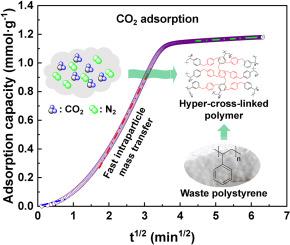Synthesis of porous hypercrosslinked polymers from waste polystyrene for efficient CO2 separation
IF 4.8
3区 材料科学
Q1 CHEMISTRY, APPLIED
引用次数: 0
Abstract
A series of porous hypercrosslinked polymers (HCP-x) were synthesized from waste polystyrene foam via Fridel-Crafts alkylation reaction, aiming to optimize the utilization of waste plastics. The impact of various crosslinkers on the structural characteristics and CO2 adsorption properties of HCP-x was investigated. The results indicated that HCP-x polymers possess high specific surface areas spanning 830–1182 m2 g−1, abundant narrow micropores, and exceptional thermal stability. Notably, HCP-2 exhibited the highest CO2 adsorption capacity of 2.77 mmol g−1 at 273 K and 1.0 bar. These hypercrosslinked polymers also demonstrated a favorable CO2/N2 ideal selectivity and robust cyclic adsorption performance. Breakthrough experiments confirmed the selective adsorption of CO2 from simulated flue gas containing CO2/N2 (15/85). Additionally, the mechanism underlying CO2 adsorption on HCP-x was elucidated by analyzing adsorption thermodynamics and diffusion kinetics. This study not only introduces an innovative method for recycling waste polystyrene foam but also underscores the potential of HCP-x as an effective adsorbent for CO2 capture.

利用废聚苯乙烯合成多孔超交联聚合物,实现高效二氧化碳分离
以废弃聚苯乙烯泡沫为原料,通过 Fridel-Crafts 烷基化反应合成了一系列多孔超交联聚合物(HCP-x),旨在优化废弃塑料的利用。研究了各种交联剂对 HCP-x 结构特征和二氧化碳吸附性能的影响。结果表明,HCP-x 聚合物具有 830-1182 m2 g-1 的高比表面积、丰富的狭窄微孔和优异的热稳定性。值得注意的是,HCP-2 在 273 K 和 1.0 bar 条件下的二氧化碳吸附容量最高,达到 2.77 mmol g-1。这些超交联聚合物还表现出良好的 CO2/N2 理想选择性和强大的循环吸附性能。突破性实验证实了从含有 CO2/N2 (15/85) 的模拟烟气中选择性吸附 CO2 的能力。此外,通过分析吸附热力学和扩散动力学,阐明了 HCP-x 吸附二氧化碳的机理。这项研究不仅介绍了一种回收利用废弃聚苯乙烯泡沫的创新方法,还强调了 HCP-x 作为一种有效的二氧化碳捕获吸附剂的潜力。
本文章由计算机程序翻译,如有差异,请以英文原文为准。
求助全文
约1分钟内获得全文
求助全文
来源期刊

Microporous and Mesoporous Materials
化学-材料科学:综合
CiteScore
10.70
自引率
5.80%
发文量
649
审稿时长
26 days
期刊介绍:
Microporous and Mesoporous Materials covers novel and significant aspects of porous solids classified as either microporous (pore size up to 2 nm) or mesoporous (pore size 2 to 50 nm). The porosity should have a specific impact on the material properties or application. Typical examples are zeolites and zeolite-like materials, pillared materials, clathrasils and clathrates, carbon molecular sieves, ordered mesoporous materials, organic/inorganic porous hybrid materials, or porous metal oxides. Both natural and synthetic porous materials are within the scope of the journal.
Topics which are particularly of interest include:
All aspects of natural microporous and mesoporous solids
The synthesis of crystalline or amorphous porous materials
The physico-chemical characterization of microporous and mesoporous solids, especially spectroscopic and microscopic
The modification of microporous and mesoporous solids, for example by ion exchange or solid-state reactions
All topics related to diffusion of mobile species in the pores of microporous and mesoporous materials
Adsorption (and other separation techniques) using microporous or mesoporous adsorbents
Catalysis by microporous and mesoporous materials
Host/guest interactions
Theoretical chemistry and modelling of host/guest interactions
All topics related to the application of microporous and mesoporous materials in industrial catalysis, separation technology, environmental protection, electrochemistry, membranes, sensors, optical devices, etc.
 求助内容:
求助内容: 应助结果提醒方式:
应助结果提醒方式:


